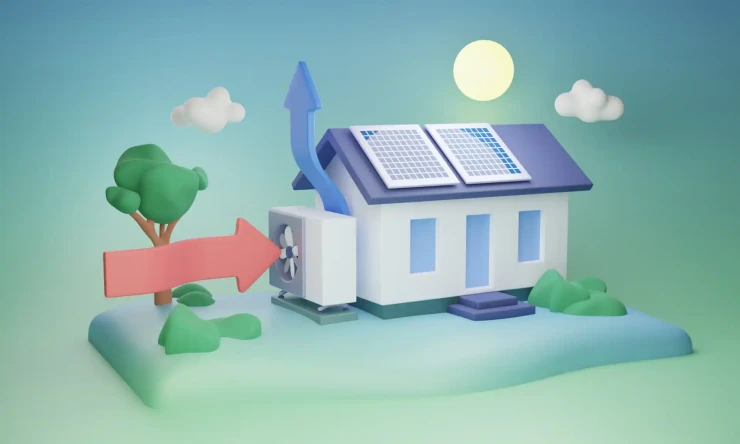
The Energy Efficiency Movement (EEM), founded by Switzerland’s ABB and made up of a global forum of more than 400 organisations worldwide has published a new report titled “The Case for Industrial Energy Efficiency.” The report aims to translate a “playbook” published by the group last year into a strategic framework for driving investment in energy efficiency measures.
The industry group which brings together organisations like Sweden’s Alpha Laval Germany’s DHL group and Microsoft from across the buildings, energy, and technology sectors has set out a series of ‘mature and concrete’ energy efficiency measures it claims could save up to 10 and 5.3 gigatons of carbon emissions a year by 2030.
Tarak Mehta, executive committee member at ABB, said it was vital to show that "mature and concrete" technology solutions are easily available to rein in global energy use.
"Since renewables can only provide a part of the answer, the critical role energy efficiency plays in accelerating the energy transition toward reaching net zero emissions by 2050 is undeniable. The urgency is for the private sector to act now. This new report is designed to help speed the adoption of best practices by showing businesses how to realise the full potential of environmental and financial benefits.”
According to the Energy Efficiency Movement (EEM), key energy efficiency actions such as the use of smart building energy management systems, switching to EV fleets, shifting to cloud-based data systems, and using heat pumps when applied across industry have the potential to reduce global carbon emissions by 11% to 2030. This is the equivalent of 4 gigatonnes with potential annual cost savings of $437bn.
The report states that a Building Management System (BMS) can be used to control 70% of a building's energy load if lighting is included as well. Modelling undertaken by EEM indicates that widespread use of building management systems (BMS) could yield annual electricity savings of between 994TWh and 1.5PWh a year by 2030 while cutting annual gas use by 126 to 252TWh. This could deliver between 593 and 901 MtCO2 emissions savings a year. If you take a mid-point estimate, this could create almost 3.5 gigatons of savings between 2024 and 2030. If you combine artificial intelligence with a digital BMS you can cut HVAC emissions by as much as 40% and reduce energy costs by 25%.
A smart BMS can also save considerable proportions of a building’s energy use costs through detection, diagnostic, historical analysis, and predictive capabilities. The report cites at least three reasons why cloud data centre operators will tend to have greater efficiency savings. For one, cloud computing and co-location facilities usually operate at a much higher level of efficiency compared to smaller, on-premises servers. Also, energy use accounts for a significant percentage of a cloud operator’s overall operating expenses, so there is a strong financial incentive to optimize the operational efficiency of IT equipment. Furthermore, advanced infrastructure technologies in hyperscale data centres reduce the energy for lighting and cooling the facility.
The Case for Industrial Energy Efficiency outlines energy efficiency actions across three strategic pillars, driving efficiency returns, gaining efficiency insights, and building an efficiency foundation. The report claims that if companies doubled down on efficiency measures four gigatonnes of carbon emissions could be saved by 2030 each year which would be the equivalent of taking 60% of the world's internal combustion vehicles off the roads.
The report offers corporate leaders insights into ten measures that leverage mature technologies to reduce costs and emissions without complex projects as swiftly as possible. For example, companies are advised to build an ‘efficiency’ foundation through regular energy audits, the “right-sizing” of infrastructure, and connecting physical assets through the “internet of things”, all measures that would improve energy efficiency. According to the analysis, the connecting of physical assets through the "internet of things" has the potential to cut emissions by a third in many organisations. It also urges companies to ‘drive energy efficiency’ by investing in high-efficiency motors, variable speed drives, electric vehicle fleets, efficient heat exchangers, and a transition to heat pumps which is a move with the potential to cut emissions by 18%.
According to ABB data cited within the report, significant benefits can be achieved by integrating industrial assets into an Internet of Things (IoT) network.
The EEM estimates that bringing connectivity to currently unconnected industrial assets could save 10% of their electricity and 5% of their natural gas consumption under a low-efficiency scenario, and 22% and 11%, respectively, in a higher growth outlook.
Most industrial enterprises waste large amounts of energy but don’t realise it. This is due to oversized machines, assets on standby, and poorly maintained hardware which all contribute to ghost loads that use power without any useful output.
In order to locate these ghost loads an energy audit needs to be conducted usually by an established energy service company. An energy audit gives companies a way of measuring progress on efficiency as well as potentially contributing to the company’s broader aims such as the achievement of ISO 50001 certification. Audits should be carried out at regular intervals and if accompanied by a sensor deployment program can lead to continuous monitoring of energy use across the enterprise, allowing savings to be achieved in real time.
The EEM says that most industrial assets tend to be oversized for a range of reasons such as building in safety margins or allowing processes to cope with peaks in demand. The report states that significant improvements can be made by right-sizing equipment and cites the example of a company that was able to remove an entire packaging line, saving $1 million a year.
EEM ‘s report says that heat pumps are extremely efficient, effectively giving back more energy than is put in to operate them. EEM predicts that in time it is likely that all low-temperature and many mid-temperature industrial applications, such as drying, and ethylene processing will use heat pumps. The EEM’s report also says that heat exchangers, which are used widely in building heating and air conditioning, refrigeration, and data centre and fuel cell cooling, are rarely maintained sufficiently.
This lack of maintenance in EEM’s view, could account for up to 2.5% of global carbon emissions which is roughly the equivalent of the entire airline industry. New heat exchangers can be up to 25% more efficient than the old ones.
According to the report around two-thirds of electricity consumption likely relates to powering motors in pumps, fans, compressors, and other equipment within industrial enterprises. It adds that if the 300 million-plus industrial electric motor-driven systems operating today were replaced with optimised, high-efficiency versions, worldwide electricity consumption could be cut by up to 10%. The Energy Efficiency Movement also says that global commercial and industrial sectors could save up to $68.8bn a year by 2030 from improved motor efficiency and reduced electricity use.
In its analysis, the EEM found that less than a third of industrial drives have variable speeds that adjust the power consumption, and emissions, to the load required. This level could be roughly doubled in most industrial settings, cutting electricity costs and emissions while saving on maintenance and reducing downtime by helping the drives last longer.
When it comes to electrifying industrial vehicle fleets, the report says that electric vehicles can cut emissions by about 17% on traditional grids and 30% on electricity from mostly renewable sources. By 2050, emissions could be reduced by 70% under a decarbonised grid.
According to the International Energy Agency doubling energy efficiency by 2030 could cut global greenhouse gas emissions by almost a third. The EEM estimates that if the 10 measures were applied across industries, a midpoint scenario could be reached with 1.5 gigatons of carbon emissions being saved annually by 2024 and under a more ambitious scenario 2030 savings could reach 5.3 gigatons, equivalent to around 15 percent of the world's projected emissions for that year.
Furthermore, in the case of the five actions where financial savings can be meaningfully calculated, the report argues that industry could save $172bn a year in 2024 rising to $437bn annually by 2030.
The analysis covers the steel, aluminium, chemicals, paper, and cement sectors, as well as those sectors classified as "light industry" by the International Energy Agency (IEA), such as food, machinery, textiles, vehicles, timber, construction, and mining.
The report underlines the urgency for the private sector to take up energy-efficient practices to expedite the energy transition toward net-zero emissions by 2050 in alignment with COP28 discussions and IEA recommendations for increased annual energy efficiency progress and investment.
Mike Umiker, managing director at the Energy Efficiency Movement, said the group hoped the report would help to communicate important information for the discussions at the COP28 Climate Summit. The UAE hosts of COP28 would like to see countries agree to a new target to double the global rate of energy efficiency improvement by 2030.
"The IEA has said that Net Zero will require a doubling of the rate of progress on efficiency and a tripling in annual efficiency-related investment. To that end, we are furnishing executives with data and insights to help build their companies' business cases for energy efficiency improvements. The report demonstrates how investments in efficiency can serve as a valuable hedge against energy and carbon price volatility while making a true, needle-moving impact on emissions. Energy efficiency is the industry's biggest emissions ally this decade."
Find a local installer
Welcome to the biggest directory of UK renewable energy companies





























